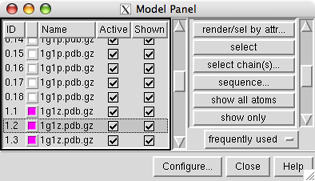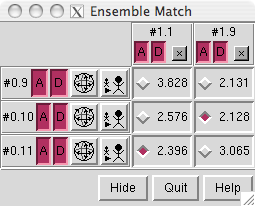
This tutorial focuses on using the Model Panel and handling ensembles of structures (such as those determined by NMR).
We will view solution structures of a toxin that binds to sodium channels. Separate ensembles were determined for cis- and trans-proline conformations of this toxin:
L. Volpon, H. Lamthanh, J. Barbier, N. Gilles, J. Molgo, A. Menez, and J.M. Lancelin, "NMR solution structures of δ-conotoxin EVIA from Conus ermineus that selectively acts on vertebrate neuronal Na+ channels" J Biol Chem 279:21356 (2004).On Windows/Mac, click the chimera icon; on UNIX, start Chimera from the system prompt:
unix: chimeraA basic Chimera window should appear after a few seconds; resize it as desired. Open the Command Line (choosing Tools... General Controls... Command Line is one way).
If you have internet connectivity, structures can be obtained directly from the Protein Data Bank:
Command: open 1g1pIf you do not have internet connectivity, you can download the files 1g1p.pdb.gz and 1g1z.pdb.gz into your working directory and then open them in that order as local files (with File... Open). It is not necessary to uncompress the files.
Command: open 1g1z
Simplify the view to alpha-carbon traces and thicken the lines:
Command: chain @caAn alpha-carbon trace connects the alpha-carbons of amino acid residues that are directly bonded to each other, either sequentially in the peptide chain or by sidechain crosslinks such as disulfide bonds.
Command: line 2
Rotate, translate, and scale the structures as desired throughout the tutorial. Optionally, use the Side View to scale the view and move the front and back clipping planes. There are several ways to start tools, including from the menu (in this case, Tools... Viewing Controls... Side View) or with a command:
Command: start Side View
Open the Model Panel:
Command: start Model PanelEach file of coordinates opened in Chimera becomes a model with an associated ID number and model color. Some PDB files are further subdivided into multiple structures designated with MODEL and ENDMDL records; these are assigned submodel numbers. Each structure can be specified independently by number (model.submodel) and handled just as if it were a separate model. Thus, the term "model" often indicates anything with its own line in the Model Panel, whether it is a submodel or a model not subdivided into submodels.
 |
Each of these files contains an ensemble of 18 structures. 1g1p (trans-proline conformations, white) has been opened as models 0.1-0.18 and 1g1z (cis-proline conformations, magenta) as models 1.1-1.18.
At first, most of the functions on the right side of the Model Panel are grayed out because none of the models are chosen. Choose model 1.2 by clicking its ID or name on the left side of the Model Panel, then try various functions:
show only - hide the other modelsin the menu: Actions... Color... by heteroatom
show all atoms - display all atoms
select - select the entire model for further operations
Sulfur atoms are shown in yellow; the structure contains three disulfide bonds.
Back to the Model Panel:
sequence... opens a sequence panel for the model. Two short beta-strands are highlighted in green. Placing the cursor over a residue in the sequence shows the corresponding structure residue number; the strands are residues 24-26 and 28-30. Secondary structure assignments (locations of any alpha-helices and beta-strands) were automatically determined from the coordinates when the files were opened. Highlight a string of residues in the sequence panel with the mouse and see how they become selected in the structure. Close the sequence panel, then act on the selection with the menu: Actions... Color... cyanClear the selection, display ribbons, and hide atoms: in the menu: Select... Clear Selection
The ribbon shows as "arrows" the beta-strands formed by residues 24-26 and 28-30. However, the paper describes three beta-strands, comprised of residues 8-10, 23-26, and 28-31. Such differences are common because secondary structure assignments are method- and parameter-dependent. Rather than trying to reproduce these results (which might not be possible) by recomputing secondary structure in Chimera with different criteria, change the assignments directly:
Command: setattr r isStrand true :8-10,23-26,28-31(There should not be any spaces after the commas.) This sets the residue attribute named isStrand to true for the specified residues in all models. Although not necessary in this case, the previous assignments could have been cleared first, for example with:
Command: setattr r isHelix falseSecondary structure assignments can also be changed by selecting amino acid residues, opening the Selection Inspector, and changing Residue settings.
Command: setattr r isStrand false
Back to the Model Panel:
color by SS... (it may be necessary to change from the frequently used list to the infrequently used to see this button) opens Color Secondary Structure. The model chosen in the Model Panel (1.2) is automatically already chosen in this dialog. Click OK to use the default colors.The Shown checkboxes toggle model display without changing the display settings of individual atoms, bonds, and ribbon segments. Using the Shown checkbox is equivalent to using the command modeldisplay. Show all of the models:
uncheck the Shown checkbox for model 1.2
check the Shown checkbox for model 1.2
Command: modeldisplayThe Active checkboxes in the Model Panel control what can be moved:
uncheck the Active checkbox for model 1.2 and try moving the structures with the mouse; now only the other models can be rotated and translatedRestore the position of model 1.2 relative to the others:
check the Active checkbox for model 1.2 and try moving the structures again
Command: matrixcopy #1.1 #1.2The first number could have been the number of any other model, since only model 1.2 was moved separately.
We will use Ensemble Cluster to cluster each ensemble and identify representative structures, then compare the representatives with Ensemble Match.
Start Ensemble Cluster (under Tools... MD/Ensemble Analysis) and choose 1g1p as the ensemble to cluster. Leave the Parts to Match blank to use all atoms and click OK. Results are shown in a cluster list dialog; three clusters were found. In that dialog,
click the black arrowhead to reveal the Treatment of Chosen ClustersClick show only on the right side of the Model Panel (it may be necessary to switch back to the frequently used list). Delete the rest of the 1g1p ensemble in model 0:
choose all three cluster lines in the dialog with the mouse; this recolors all the 1g1p structures, using three different colors for the three clusters, and chooses their lines in the Model Panel
change the third treatment option to choose only the representatives in the Model Panel
Command: delete #0/!displayThis deletes models with ID number 0 and model display turned off (!display is the opposite of display). Quit from the cluster list dialog.
Start Ensemble Cluster again and cluster 1g1z using all atoms. This time, four clusters are found. In the cluster dialog, make sure the treatment is to choose only representatives in the Model Panel. Choose just the two clusters with more than one structure and then, as before, click show only in the Model Panel. Quit from the cluster dialog and delete the rest of the 1g1z ensemble:
Command: delete #1/!displayDrag with the mouse to choose all five remaining models in the left side of the Model Panel. On the right side,
click show only to show all fiveFinally, compare the structures with Ensemble Match (under Tools... MD/Ensemble Analysis). Choose one ensemble as the reference and the other as the alternative. For Parts to Match just specify the backbone atoms:
click rainbow... and in the resulting dialog, click OK to give each model a different color in the rainbow range
click tile... (it may be in the infrequently used list) and in the resulting dialog, decrease Border scale to –0.2 and click OK to spread the models out in a plane
@n@ca@c@o
 |
Click OK to calculate the matches. Results are shown as a 3 x 2 (or 2 x 3) table with entries for all pairwise comparisons between the ensembles. The A and D buttons control model activation for motion and model display, respectively. The numbers in the table are pairwise RMSDs using the atoms that were specified as Parts to Match.
The structures are not yet superimposed. Clicking a button next to an RMSD value performs the corresponding match and reports in the status line the number of atom pairs used. Superimpose each cis-proline conformation in model 1 on the most similar (lowest-RMSD) trans-proline conformation in model 0.
In this case, cis and trans refer to the peptide bond between leucine-12 and proline-13. Display these residues as ball-and-stick:
Command: disp :12-13When finished viewing the structures, choose File... Quit from the menu to exit from Chimera.
Command: repr bs